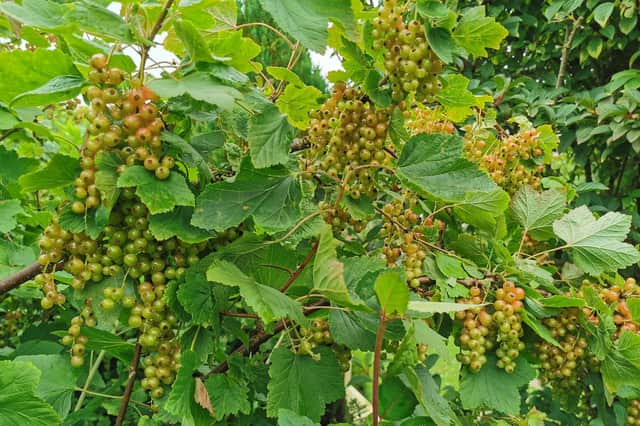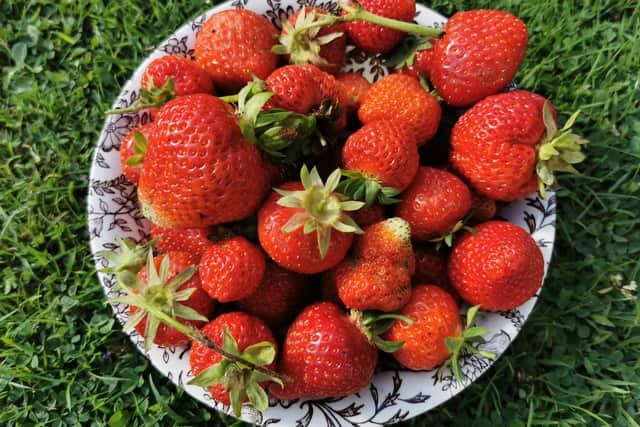The most fruitful of activities in the garden


There will be no respite from the daily collecting bowl-in-hand approach until the end of October, as the other bush and tree species weigh-in with their contributions.
Anyone can grow a few tasty, fresh berries of their choice in our northern climate, as most types lend themselves to pot or container culture; the absence of a garden is not a problem. Indeed, dwarf varieties covering a diversity of soft and top fruits have been bred for this very purpose.
Advertisement
Hide AdAdvertisement
Hide AdIn this garden we have a decent range of edible fruit-bearing plants that were chosen for June to November production. Strawberries herald the beginning and as Christmas countdown approaches, we can still be picking autumn raspberries and storing apples. Whereas gathering from one plant can continue for several weeks e.g. raspberries, we wait until the majority of black and red currants are ripe and harvest them in a single day. Any left to ripen are taken by birds.


My key performers are raspberries, strawberries, currants, gooseberries and thornless blackberries. Because the first mentioned has cultivars that cover different phases of summer and autumn it represents real value for money. I find the following varieties (in order of ripening) so reliable: Glen Ample, Octavia, Tulameen, Joan J and All Gold.
Raspberry plants currently bearing ripe fruits are doing so on one year old canes that grew up and matured last summer. So, traditionally, there has been a waiting period between buying, planting and the first taste. However, the introduction of the ‘long cane’ type has shortened the timescale. They can be bought at one metre plus in length, planted in early spring, and bear fruit the same summer.
On balance, growing soft fruits, be it in containers or the open garden, can be so rewarding. It’s not just the delicious product but also the observation of growth process from flowers to fruit formation and ripening. Then the choice of use; Is it to be immediate consumption, freezer storage or jam-making?
Advertisement
Hide AdAdvertisement
Hide AdIt’s difficult to think of any negatives attached to the growing of these productive plants other than the occasional pest wanting a piece of the action, stained fingers from over-zealous picking, and the topping and tailing of gooseberries for the freezer!
SOME SOUND ADVICE FROM AN OLD HAND
A few tips gleaned from years of growing soft fruits might not go amiss.
I never keep strawberry plants into a fifth year because they lose vigour with age, are more susceptible to pests and diseases and become less productive. Replace the oldest every year with young plants that appear on the end of runners.
These form roots of their own accord as summer progresses but speed up the process by pegging them into the soil surface or a small pot of compost placed alongside the plant.
Advertisement
Hide AdAdvertisement
Hide AdTidy the bed in deepest autumn and apply an organic mulch between the rows.
Raspberries have roots just below the surface so go easy with any hoeing. Pruning of summer fruiting types comes immediately after the crop is picked. Remove all canes that have borne fruit down to ground level and tie in the young canes that remain.
Canes of autumn bearing raspberries are also pruned to ground after fruiting to encourage new growths in spring.
Plant young blackcurrant bushes slightly deeper than they were in the pot to encourage a regular supply of growths from below soil level in future.
Advertisement
Hide AdAdvertisement
Hide AdAs the plant matures, prune out one or two of the old fruit-bearing stems each year.
Do this immediately after fruiting or wait until leaf fall for a clear view of the plant shape.
Don’t allow the centre of a gooseberry bush to become congested for that encourages mildew and harbours pests. Train main stems to canes that radiate outward from the base of the bush creating a goblet shape. This facilitates air circulation and allows easier access for picking.
Nutritious blueberries prefer an acid to medium soil. Plant the cultivar North Country for the bonus of cheerful white spring flowers and attractive autumn foliage.